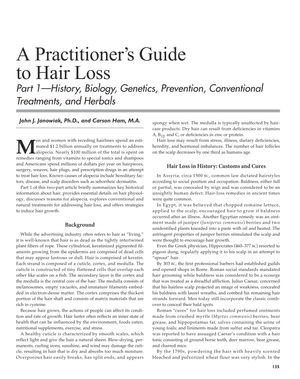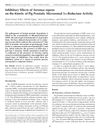A Practitioner's Guide to Hair Loss Part 1—History, Biology, Genetics, Prevention, Conventional Treatments, and Herbals
June 2004
in “Alternative and Complementary Therapies”

TLDR The document concludes that hair loss is influenced by genetics and other factors, and while treatments like finasteride can help, they have limitations and side effects.
The document from 2004 provides a detailed examination of hair loss, discussing its history, biology, genetics, and various treatment options. It reveals that Americans spend about $1.2 billion annually on hair loss treatments and that hair loss can be attributed to factors such as heredity, disease, and scalp conditions. The paper clarifies that hair is made of dead cells and keratin, and its health can be affected by the environment, diet, and stress. It outlines the phases of hair growth and the significant role genetics play in hair loss, with the first gene related to hair growth identified in 1998. The document reports that 80% of American men experience hair loss, with male pattern baldness prevalent after age 40, and that women also suffer from hair loss, especially post-menopause. It discusses the effectiveness of Propecia (finasteride) in promoting hair regrowth in men in their 20s and 30s, with a clinical trial showing 80% experienced new hair growth. However, it also notes the side effects and limitations of finasteride. Hair transplants and herbal remedies are also covered, with some herbal treatments showing promising results in clinical trials. The document emphasizes the need for compassionate treatment of hair loss and informed medical advice.
View this study on liebertpub.com →
Cited in this study

research A Randomized, Double-Blind, Placebo-Controlled Trial to Determine the Effectiveness of Botanically Derived Inhibitors of 5-Alpha-Reductase in the Treatment of Androgenetic Alopecia
Plant extracts effectively reduce hair loss and increase growth, offering a safe alternative treatment.
research The first clinical trial of topical application of procyanidin B‐2 to investigate its potential as a hair growing agent
Procyanidin B-2 lotion might help men grow thicker hair without side effects.
research Morphogenesis and Renewal of Hair Follicles from Adult Multipotent Stem Cells
Adult mouse skin contains stem cells that can create new hair, skin, and oil glands.

research Finasteride in the treatment of men with androgenetic alopecia
Finasteride safely and effectively treats male pattern hair loss, but may cause reversible sexual issues and harm male fetuses.

research Inhibitory Effects of Serenoa repens on the Kinetic of Pig Prostatic Microsomal 5α-Reductase Activity
Saw palmetto extract can block the enzyme that converts testosterone in pig prostate cells.

research Quantitative Estimation of Hair Growth I. Androgenetic Alopecia in Women: Effect of Minoxidil
Minoxidil promotes hair growth in women with early-stage alopecia.

research Long-term efficacy of topical minoxidil in male pattern baldness
Topical minoxidil effectively treats male pattern baldness and prevents hair loss.